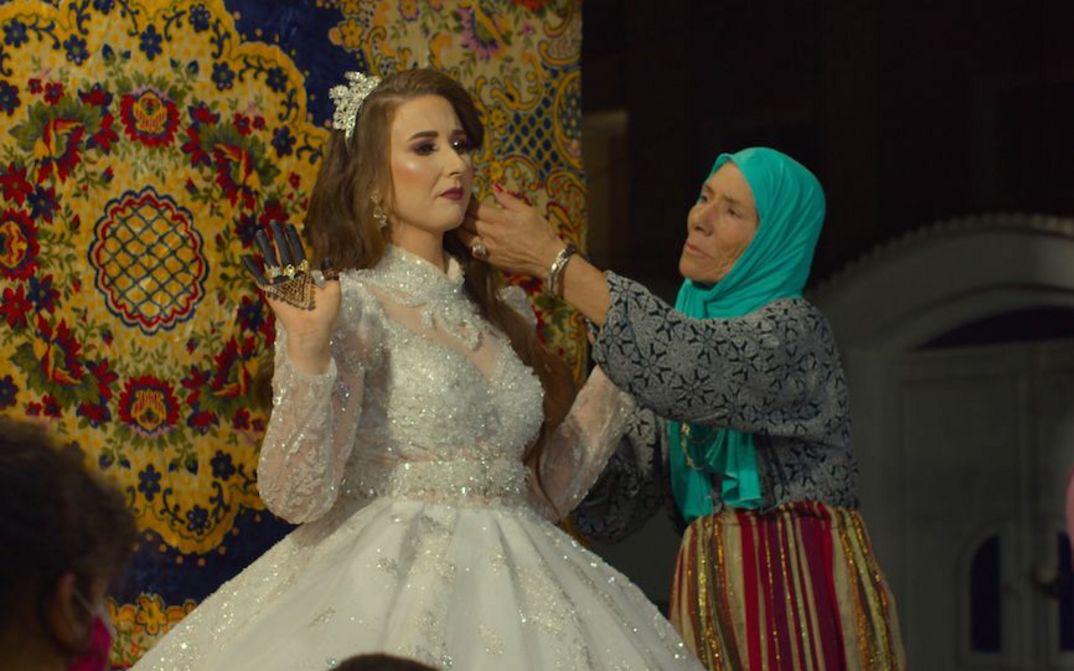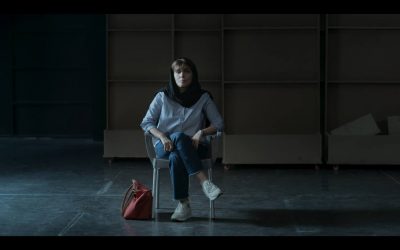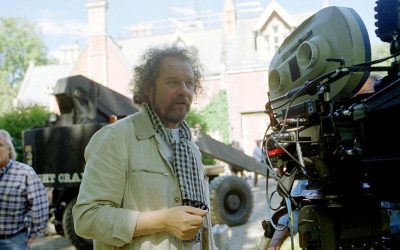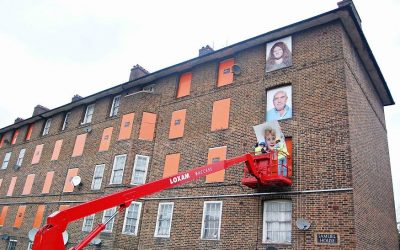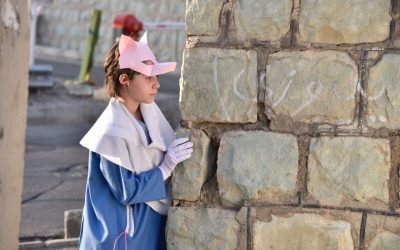 Pascale Fakhry is the Executive Director of ALFILM – Arab Film Festival Berlin. She holds a PhD in Film and Gender Studies from Paris 3 University (Sorbonne Nouvelle), France, and has authored numerous articles on gender and representation in American genre cinema. Since joining ALFILM in 2013 as a programmer and organizer, she has played a key role in shaping the festival’s vision. In addition to her work in film curation, she is an experienced film editor, having contributed to various feature and documentary projects. She also served as the project manager for “Cinema on the Road” at Metropolis Cinema, Beirut (2017), and “Cinema of Commoning” at Sinema Transtopia, Berlin (2024).
Pascale Fakhry is the Executive Director of ALFILM – Arab Film Festival Berlin. She holds a PhD in Film and Gender Studies from Paris 3 University (Sorbonne Nouvelle), France, and has authored numerous articles on gender and representation in American genre cinema. Since joining ALFILM in 2013 as a programmer and organizer, she has played a key role in shaping the festival’s vision. In addition to her work in film curation, she is an experienced film editor, having contributed to various feature and documentary projects. She also served as the project manager for “Cinema on the Road” at Metropolis Cinema, Beirut (2017), and “Cinema of Commoning” at Sinema Transtopia, Berlin (2024).
Redcut: Considering the historical, political, and social contexts, how do you assess the evolution of Arab cinema from the early 20th century to the present, and which milestones would you identify as having shaped the discourse of Arab cinema on an international level?
This is a complex question, and I will try to answer it as concisely as possible, while taking into account the political, cultural, and social specificities of each country, which have shaped the emergence and development of their respective national cinemas.
The evolution of Arab cinema from the early 20th century to the present reflects a dynamic interplay between artistic expression, political realities, and shifting social identities across the Arab world. Emerging during the colonial period, cinema in Egypt, Lebanon, and later Syria and Morocco became both a medium of entertainment and a tool of cultural self-definition.
Early Foundations (1920s–1950s):
Arab cinema began in Egypt, which became the region’s cinematic hub. The Studio Misr (founded in 1935) institutionalized film production, creating a Golden Age (1940s–1950s) marked by musicals and melodramas that mirrored Egypt’s national aspirations and social transformations under Nasser. These films established a regional cinematic identity, influencing audiences across the Arab world.
“Postcolonial” and Political Cinema (1960s–1980s):
After independence movements swept North Africa and the Middle East, filmmakers began using cinema as a political and cultural weapon. Directors like Youssef Chahine (Egypt), Tewfik Saleh and Omar Amiralay (Syria) tackled themes of nationalism, social injustice, and identity. In Algeria, films such as The Battle of Algiers (Gillo Pontecorvo, 1966) became international milestones — merging revolutionary politics with cinematic innovation and influencing global political cinema.
Diasporic and Experimental Phases (1990s–2000s):
As political repression and censorship increased, many Arab filmmakers worked in exile or through international co-productions. The Lebanese Civil War (1975–1990) spurred a wave of introspective, hybrid works exploring memory and trauma, notably by Jocelyne Saab, Maroun Bagdadi and Burhan Alawiyeh. In Palestinian cinema, Elia Suleiman and Hany Abu-Assad reframed national struggle through irony and allegory, earning international recognition.
Contemporary Transformations (2010s–Present):
The Arab Spring (2011) marked a new chapter — both technologically and thematically. Digital filmmaking and social media enabled new voices from Tunisia, Egypt, and beyond to emerge, often blending documentary and fiction. Works like Nadine Labaki’s Capernaum (2018) and Kaouther Ben Hania’s The Man Who Sold His Skin (2020) brought Arab cinema renewed global visibility, addressing issues of displacement, gender, and human rights.
In conclusion, Arab cinema has evolved from national and ideological narratives to complex transnational forms that question identity, power, and representation. Its international discourse now balances between challenging stereotypes and asserting creative autonomy in a globalized cinematic landscape.
Redcut: In recent decades, the presence and voices of women filmmakers in Arab cinema have become more prominent. From your perspective, to what extent has this movement been able to challenge patriarchal narrative structures, and what role has it played in redefining the identity of Arab cinema?
In recent decades, women filmmakers have played a crucial role in reshaping both the aesthetics and the narratives of Arab cinema. Their growing presence has not only diversified the industry but also challenged the patriarchal structures that traditionally framed women as objects rather than subjects of cinematic discourse. Directors such as Jocelyne Saab, Randa Chahal Sabag, Eliane Raheb or Nadine Labaki in Lebanon, Leila Kilani and Myriam Touzani in Morocco, Kaouther Ben Hania or Leila Bouzid in Tunisia, Annemarie Jacir and Larissa Sansour in Palestine, among so many others, have foregrounded women’s experiences, using cinema as a space for agency, critique, and self-representation.
Through themes of gender, class, migration, and everyday resistance, these filmmakers have introduced new narrative forms — often blending realism, irony, and poetic introspection — to question dominant moral and social orders. Their work also redefines Arab cinema on an international level: it moves beyond the tropes of political conflict and exoticism that once dominated global perceptions, instead presenting complex, humanistic, and locally grounded perspectives.
In this sense, the rise of women filmmakers has not only disrupted patriarchal storytelling but has also expanded the identity of Arab cinema itself, transforming it into a more inclusive, plural, and globally resonant cultural practice.
Redcut: Arab cinema is often subject to the expectations and pre-established frameworks of Western audiences and cultural institutions. How does your festival strike a balance between presenting an authentic image and resisting an orientalist gaze?
This is indeed a crucial question, as Arab cinema is often filtered through Western frameworks and expectations. At ALFILM, our mission has always been to present an Arab perspective on the Arab world — one that reflects the diversity, creativity, and complexity of the region rather than mirroring externally imposed narratives.
We consciously counter stereotypical and exoticized portrayals by focusing on films that speak from within Arab societies, foregrounding local voices, and exploring both contemporary realities and aesthetic innovation. Our leadership and curatorial team come mostly from the Arab world, which ensures a deep cultural understanding and sensitivity in how the films are selected and contextualized.
The success of ALFILM, I believe, lies precisely in its refusal to reproduce exotic perspectives. Instead, we aim to create a platform of exchange and reflection that challenges preconceived notions while allowing audiences to engage with Arab cinema on its own terms — as a multifaceted and evolving artistic expression, not a mirror of Western imagination.
Redcut: How has your lived experience in migration influenced your understanding of cultural boundaries and informed the programming policies of the festival, particularly in fostering connections between Arab filmmakers and European host communities?
My experience of migration is an ongoing and evolving process. As an Arab living in Germany, my relationship to this country has changed profoundly since I first moved here in 2008 — especially as public discourse around the Arab world has grown noticeably more polarized, and more racist in recent years.
This shifting context has deeply influenced how I understand cultural boundaries — not as fixed lines, but as spaces of resistance, negotiation, and transformation. Living between worlds makes one acutely aware of how identities are constantly being redefined, and that awareness lies at the heart of ALFILM’s ethos. It shapes our commitment to creating a festival space that embraces complexity, challenges reductionist views, and celebrates the fluidity of cultural experiences.
This in turn is also visible in the works of the many Arab filmmakers living in the diaspora that are featured each year in ALFILM’s program. Migration, displacement, and belonging are recurring themes in Arab cinema today, and they resonate strongly with our European, Arab and International audiences who are also grappling with questions of diversity and coexistence. By presenting films that reflect these shared human experiences, we aim to foster dialogue rather than difference.
This approach also guides how we connect Arab filmmakers with European communities — through discussions, workshops, and collaborative spaces that encourage mutual curiosity and empathy. In that sense, my own migratory experience reinforces ALFILM’s commitment to being not just a showcase of cinema, but a cultural meeting point where stories cross borders as naturally as people do.
Redcut: In the process of introducing Arab cinema to Western audiences, what semantic or interpretive challenges do you encounter, and what strategies do you employ to avoid reducing works to political or cultural clichés?
One of ALFILM’s main objectives is to counter perspectives shaped by media stereotypes or orientalist frameworks, which in turn can lead to reductive readings — seeing films solely through political or cultural clichés rather than as complex artistic expressions.
We address these challenges by foregrounding the voices and intentions of the filmmakers themselves. We contextualize films through discussions, panels, and Q&A sessions, highlighting the social, aesthetic, and narrative nuances that might otherwise be overlooked. Curating a diverse selection of films — from experimental to mainstream, from different countries and genres — also helps counter singular narratives about the Arab world.
We trust our audiences to engage with complexity, and we provide the tools to appreciate Arab cinema as a multifaceted cultural and artistic practice.
Redcut: Given the infrastructural and economic limitations in many Arab countries, what models of support or international collaborative networks have you proposed or implemented to sustain and expand independent productions?
The infrastructural and economic challenges in many Arab countries make sustaining independent productions particularly difficult. At ALFILM, we’ve approached this by fostering international collaborative networks that connect Arab filmmakers with co-producers, distributors, and cultural institutions abroad. These networks help secure funding, access technical resources, and create opportunities for co-productions that might otherwise be unattainable locally.
We also emphasize capacity-building and knowledge exchange through workshops, panel discussions, and masterclasses, where experienced filmmakers share expertise with emerging talent.
Crucially, our model is rooted in cultural autonomy: partnerships are designed to support rather than dictate. This ensures that independent productions retain their creative integrity while benefiting from international visibility and resources. In this way, we strive to expand the reach of Arab cinema without compromising the authenticity of its voices.
Redcut: What criteria do you apply in selecting films for the festival so as to preserve both geographic and aesthetic diversity while also presenting contrasting and even conflicting narratives? How do you navigate external pressures—political or cultural—within this process?
At ALFILM, film selection is guided by a commitment to geographic and aesthetic diversity. We look for films that offer authentic perspectives on the Arab world, exploring a wide range of social, cultural, and political experiences — from established to emerging filmmakers, from genre films to experimental and art-house expressions. Our goal is to showcase cinema as a pluralistic and dynamic field, rather than a monolithic representation of the region.
In navigating external pressures, whether political, cultural, or commercial, we rely on the festival’s Arab leadership and curatorial autonomy. Decisions are made collectively, prioritizing the artistic integrity and thematic relevance of the works over external expectations or stereotypes. Contextualization is also key: through panels, discussions, and program notes, we provide audiences with frameworks to understand the films on their own terms, rather than through preconceived notions.
Ultimately, the festival’s mission is to foster critical engagement. By balancing diversity, artistic innovation, and ethical curatorial practices, we ensure that ALFILM presents the Arab world in its full complexity, resisting reductive narratives while amplifying its multiplicity of voices.
Redcut: With the emergence of a new generation of filmmakers and significant transformations in cinematic tools and language, what developments do you envision for the future of Arab cinema, and what active role can your festival play in shaping these horizons, particularly in relation to the global systems of distribution and exhibition?
The emergence of a new generation of Arab filmmakers, combined with the democratization of cinematic tools and evolving languages of storytelling, signals an exciting period for Arab cinema. We are witnessing works that are formally experimental, socially engaged, and globally resonant, often challenging traditional genres and narratives. I envision Arab cinema continuing to expand both aesthetically and thematically, moving beyond national boundaries while maintaining deeply rooted perspectives.
At ALFILM, our role is to nurture and amplify these emerging voices. We aim to provide platforms where new filmmakers can connect with international audiences, co-producers, and distributors, helping to navigate global systems of exhibition while preserving creative autonomy. By fostering cross-border collaborations and strategic partnerships with international institutions, we actively contribute to shaping a more sustainable and diverse ecosystem for Arab cinema.
In essence, ALFILM seeks to be both a launching pad and a bridge: enabling Arab filmmakers to experiment, be seen, and participate in global cinematic discourse — all while presenting the Arab world in its complexity, resisting simplification or exoticization.

